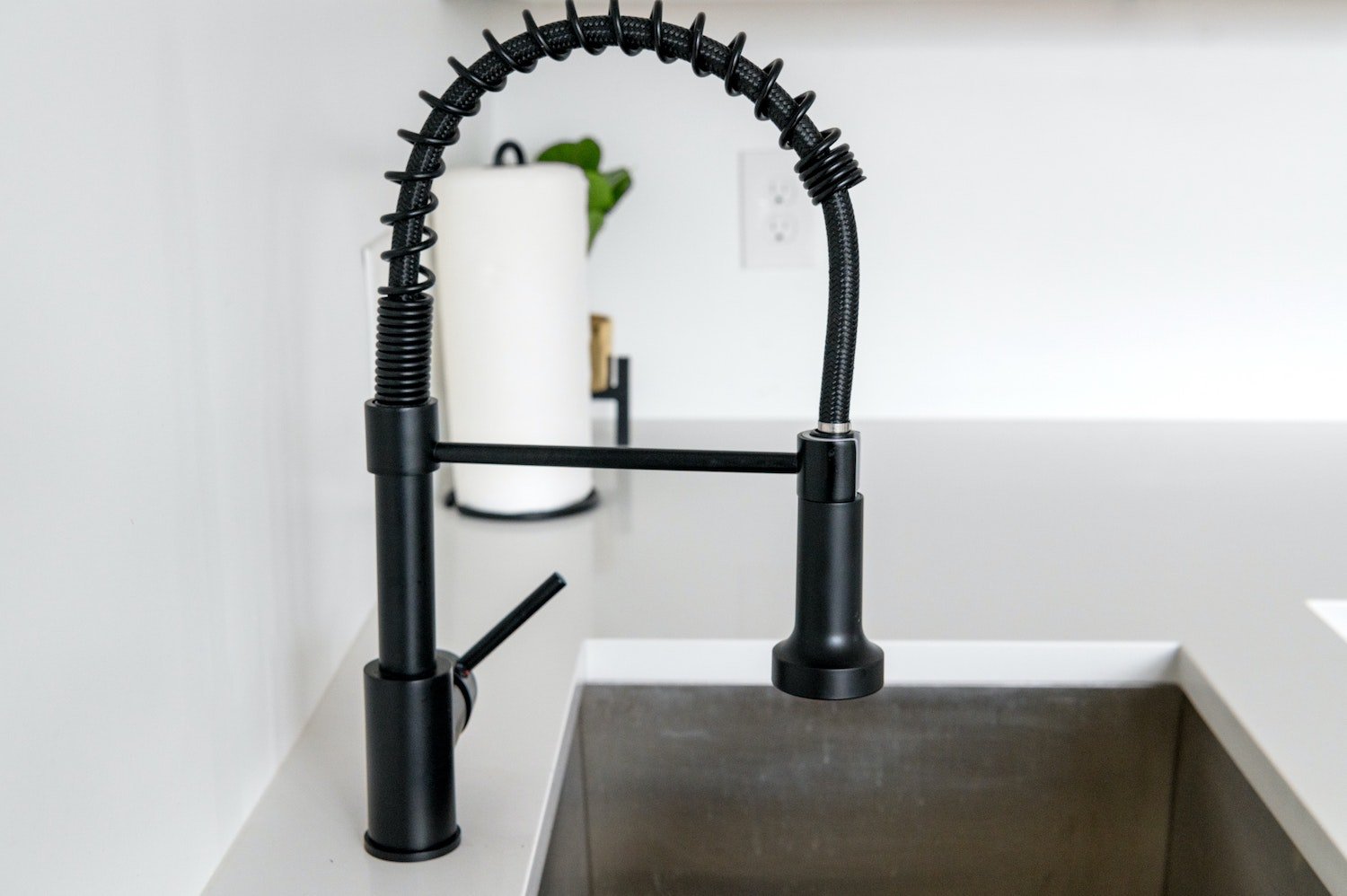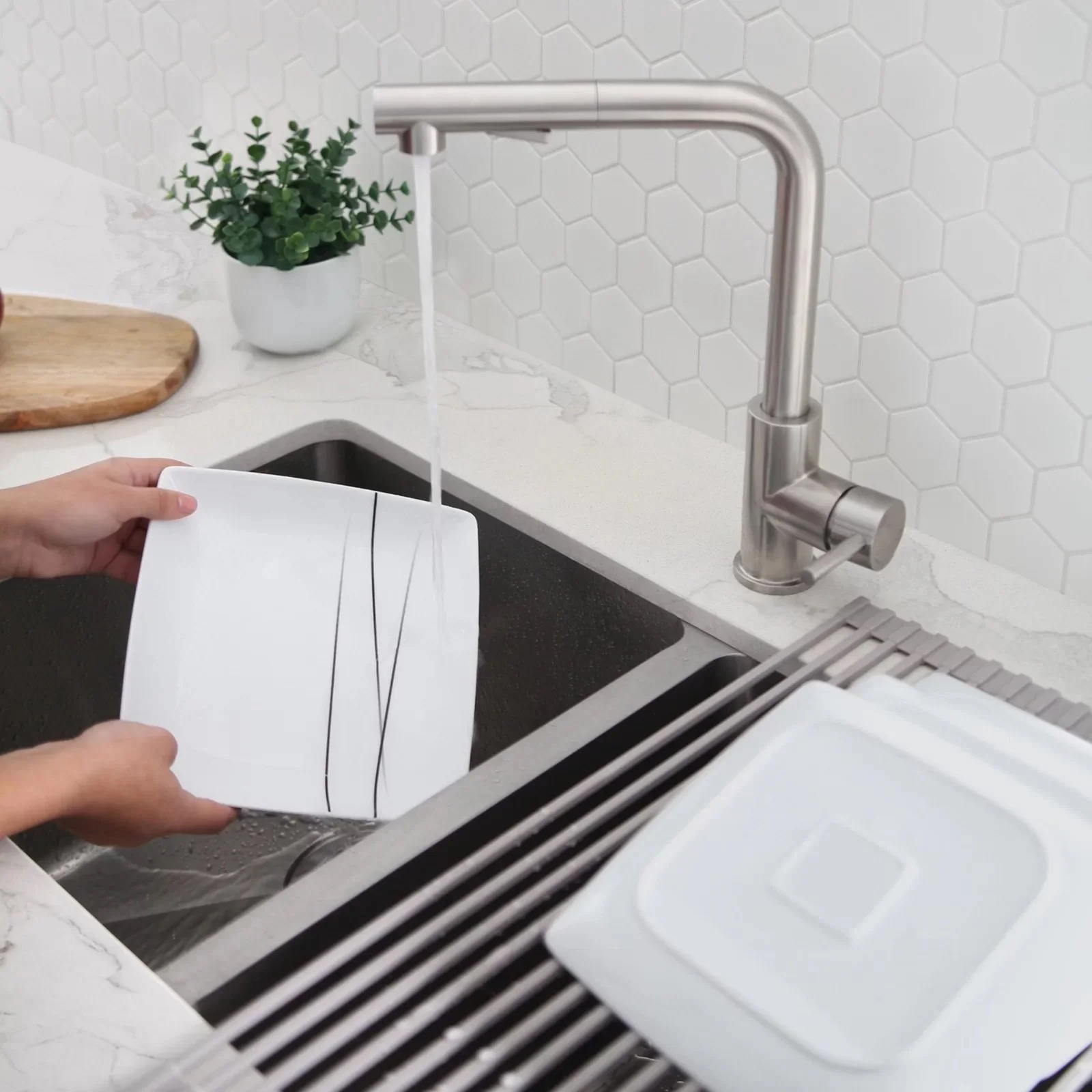July 9, 2022
A Step-by-Step Guide to Choosing the Perfect Kitchen Faucet
*Plus the best faucet choices for every budget and style
By Bri West
Picking out a kitchen faucet seems like it should be quick and easy, but a hasty choice may come back to haunt you.
Think about it…
What if, every time you go to cook pasta, your faucet’s straight spout barely clears the edge of the pot, forcing you to slosh a third of the water out just to remove it from the sink? Or, you try to clean your sink, but the water stream doesn’t reach the corners or sides of the basin? Or maybe you love the functionality of your pull-out faucet hose, but the finish color is all wrong, clashing with your appliances and cabinet pulls?
To help you avoid these, and other pitfalls, we’ve compiled the seven essential steps for choosing the best faucet for your kitchen.
Step 1: Figure Out Your Sink Hole Configuration
If you are keeping your existing sink and just choosing a new faucet, it’s crucial to match your sink’s hole configuration.
Most sinks feature one to four holes for mounting–look underneath the sink to count the number of holes accurately, since the deckplate may be hiding them:
One-hole sinks–by far the most popular configuration–require all hosing to be fed up through a single opening.
Two-hole models have either one opening for the primary sink faucet and a second for either a sprayer or soap dispenser, or a “bridge” configuration, with two handles separated by a horizontal cross-bar.
Three-hole sinks usually accommodate the main spout that dispenses water, and two separate handles. Be sure to measure the distances between the holes to determine if you need a centerset or minispread faucet (less than 4”), or widespread (more than 4”).
Four-hole mounts have the same configuration, plus an extra opening for a sprayer hose.
If you’re replacing both sink and faucet–great! You’re free to choose any configuration, as long as they correspond. While you can choose to cover extra pre-existing holes in your sink with a base plate (and therefore use a one-hose faucet with a two-hole sink), it’s not a good idea to purchase a faucet with more hoses than corresponding holes in your sink–unless you want to drill into your sink or countertop.
If you want to use a unique, custom-made, or DIY sink basin with no pre-drilled holes, a counter or wall mounted faucet is a great option–although you will need a plumber to install or reinstall your water supply lines accordingly, which brings us to…
Step 2: Choose a Mounting Style
There are three ways kitchen faucets are typically mounted:
Deck-mounted faucets, in which the spout and handle components are integrated into a single unit mount that attaches to the sink, are popular for their ease of installation and reasonable cost.
Counter-mounted faucets move the configuration behind the sink, mounted directly to the countertop. This style provides a clean and integrated look, with more space for the components–although installation is costlier and more complicated.
Wall-mounted faucets can not only save space, but also lend a professional or vintage look–like when paired with a cast iron or large farmhouse sink. However, these units tend to cost approximately 30% more, and require water lines to run behind the wall above the sink cabinet, requiring professional (and costly) installation.
Step 3: Consider Spout Height and Reach
Determining the desired function is the next step to choosing an ideal kitchen faucet.
While a straight spout faucet style is inexpensive and minimalist, it may limit functionality by not allowing you to reach all areas of the basin with water or sitting too low to fill tall pots or vessels. A goose-neck model is great for height, but could cause too much splashing if used with a shallow basin, or sit too close to over-sink shelving. If you have a farmhouse or 3-basin sink, a faucet with short reach may not work as well.
Style preference is also a factor in choosing the right spout body. If you want an industrial look, a tall, utilitarian goose-neck sprayer will look right at home. In contrast, a traditional, homey kitchen may be better suited to an ornate, lower-profile style.
Step 4: Decide what controls work best for you
How you operate your faucet is another important consideration for function–and aesthetics.
A single-handle control is the simplest and most space-saving option. While they are easiest to install and suit a wide variety of sink styles, they may not offer precise temperature adjustment in comparison to other configurations like two-handle. Also, pay attention to the handle’s length and rotation to prevent bumping your backsplash every time you turn on the water (annoying!).
Two-handle styles are harder to install and require two hands to to operate, but may provide more precision in adjusting your water temperature.
Hands-free units offer the most convenience, especially in the kitchen, where food-covered or dirty hands can leave messy prints or bacteria on sink controls. Carrying heavy pots or handfuls of produce to wash is super easy with a motion-activated control mechanism.
Pull-out or pull-down faucet configurations offer the most professional-level functionality (think restaurant kitchen). A hose that detaches from a single faucet head allows a user to reach all areas of the sink with maximum water pressure to carefully wash produce, clean out food containers, and spray off messy pans and dishes.
Step 5: Consider Specialty Faucet Types
Avid home chefs and those with high-end kitchens may choose to install specialty faucets in addition to their main unit.
A connected or separate prep or bar sink basin often features a filtered cold water spout for drinking or an instant hot water unit. Additional sink space and water availability make cooking with others or hosting larger events convenient and efficient, so consider installing a prep or bar sink if you plan on frequent entertaining or enjoy cooking with family and friends.
Common to restaurant kitchens, pot-filler faucets are mounted near your stove to fill oversized pots for cooking, and feature fold-away arms to store when not in use. While this type of fixture can be useful and convenient for serious cooks, the time and expense of installation can be prohibitive, since it requires an alternate water source.
Step 6: Choose your style + finish
Once you’ve determined which sink hole configuration, mounting style, spout height and reach, and controls you need, it’s time to consider styles and materials (the fun part!).
Have a contemporary or transitional style kitchen? Stick with neutral finishes like brushed nickel, stainless steel, or matte black that scream neither ultra modern, nor traditional. Choose a sleek or rounded-shaped spout and simple controls like integrated handles in the same metal tone.
Love traditional, farmhouse, vintage, or eclectic decor? Go outside the box with a rubbed bronze, copper, brass, or gold finish. Incorporate whimsical details like vintage hot and cold knobs or an ornately-designed bridge for a unique and eye-catching faucet set-up.
Favor modern or minimalist looks? A variety of metal finishes can work, from nickel to matte black, as well as shiny chrome or white lacquer. Steer clear of patina-ed metals and ornate details, opting instead for clean and geometric lines with monochromatic finishes.
Step 7: Who’s Going to Install?
Depending on the complexity and style of your faucet configuration, you may either choose to install the unit yourself, or to hire a professional.
Easy-mount faucet bases and snap-fit hose connectors are now included with most new units, making DIY installation relatively simple. However, if your install requires drilling into the countertop or sink basin, feeding water supply lines up to a wall-mounted unit, or adding additional openings for faucet components, you may want to consider outsourcing the job to a contractor, handyman, and/or skilled plumber.
Faucet Choices for Every Budget and Style
Completed the steps and ready to start sourcing faucets for your kitchen project? We’ve compiled a curated list of our favorites for a variety of styles and budgets to get you started…
Contemporary + Transitional Style Faucets
SAVE
PROOX Pull Down Single Handle Kitchen Faucet
Wayfair
$52.98
Commercial handle high arc, single-level stainless steel kitchen sink faucet with pull down sprayer. 15.2-inch height fits underneath almost any kitchen cabinet while the smooth-retract nylon sprayer hose with extended 20” range allows you to easily reach all areas of your sink.
SPLURGE
Stylish Pull Down Single Handle Kitchen Faucet
Wayfair
$234
A clean, bold design that suits any modern or contemporary kitchen décor. The dual-function sprayer has been designed to easily switch between aerated stream and spray water flow. The pull-out sprayer provides maximum reach for flexible functionality. The handle moves 90 degrees forward to allow an ample range of motion and to avoid hitting the backsplash. Manufactured with top-quality components to ensure superior performance and durability.









